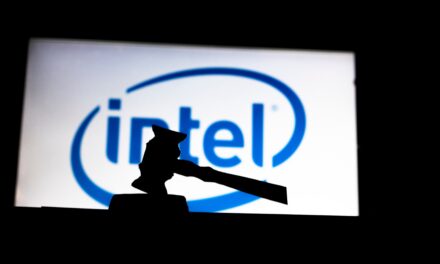Earlier this week, I told you about the ongoing Death of Intel, and why one of America’s most dominant tech companies is now headed toward extinction…
The very next day, Intel’s executives reported that they’d be laying off 15% of the company’s staff and canceling plans for new semiconductor fabrication plants. If you’re wondering why Intel’s shares are down nearly 10% today? Just watch Wednesday’s episode of Moneyball Economics.
Today, I’m going to see if we can go two-for-two on “Big Swing” predictions.
Because today, I’m going to show you why three more companies are in for tough going due to the economy and President Trump’s transformative new policies.
Let’s dive into it:
Video transcript:
Welcome to Moneyball Economics.
I’m Andrew Zatlin, and two pieces of news came across my desk this week, which at first glance, they don’t seem connected, but I’m going to connect them because I’m starting to see a very important pattern and an investment opportunity.
The two pieces of news were, number one, Diageo reported a big drop in their beer sales. And number two, president Trump met with the Fed Reserve Bank Chairman Jerome Powell. Let me take that second one.
First, let’s talk about President Trump going out and trying to strong arm Powell…
Next week, the Federal Reserve meets. They’re going to talk about interest rate cuts, and we know that Trump is putting the touch on Powell and requesting a rate cut. If we don’t have one next week, we got to wait two months to September and Trump, he’s not a patient guy.
Now, if I’m Powell, this is probably the message I’m giving Trump, I’m going to say, “Mr. President, let’s be honest. I’m out of here in a few months. You’re going to fire me anyway, so I don’t really have to be subservient to you. I don’t really have to be allegiant to you as much as I need to show my allegiance to the position, to the Federal Reserve, the American people.”
Now, Powell won’t say that, but that’s pretty much the undercurrent. What he will say is, I’m data driven. And the data right now, Mr. President, does not suggest we should do a rate cut.
Let’s start off with inflation. Inflation is not only high, it’s starting to move up thanks to your tariffs. So that’s likely not going to go away for a while. And when we look at the economy at large, things seem to be doing just fine without a rate cut. For example, we’ve got the GDP for the second quarter coming in probably around 2.5 – 3%.
That’s a good GDP. That’s an economy that’s looking good.
And then Mr. President, let’s talk about the labor market. Jobless claims have been steadily falling the last three weeks. They hit a new low recently, labor market seems strong. I don’t see a reason to cut rates. So this is where I want to come in and say, I’ve got a problem here. I think the jobless claims data is sending out a false signal. I think in fact that the jobs market is very soggy.
I think the economy is very soggy, and that means we’re going to have a big disconnect because the data right now is saying things are fine, get to September. Maybe they continue to say things are fine, when in fact the data is off and the real economy is not doing well. At which point this becomes a big, big problem where we’re going to have some emergency moves at the end of the year.
So let’s talk about why I think jobless claims are sending out a false signal.
Why do I think there’s a disconnect in the data that the Federal Reserve is going to use and they’re going to make a mistake in September and maybe not cut rates? Then let’s talk claims.
So before I do that detailed dive, let’s set the stage. Big picture. You don’t have to look very far to see all the data out there that says we have a problem in the labor market. Lemme start off with hiring intent and firing intent. Let’s talk hiring intent.
There’s something out there called JOLTS, the job opportunity layoff turnover numbers. It comes out from the BLS, the same group that brings you jobless claims and, excuse me, unemployment data. And they’re showing data that says we are at the tail end of a cycle. As you can see from this chart, what we’ve got is steadily the job openings are falling steadily, steadily, steadily.
And so are the hiring. Now, recently we’ve got a little bit of a bump up in job openings, but that’s very isolated. It was isolated mainly to the food and leisure and hospitality industries. Why? Well, because we have bad weather, and so they’re kind of catching up.
What I’m trying to say is we are on the downslope of hiring. Our economic cycle is slowing, and that was taking place before we had things like the headwinds from the tariffs and doge and ICE and so on.
We are in a cyclical slowdown and in a cyclical slowdown. You see all these reasons why we don’t hire, for example, companies, their corporate profits have fallen from double digits last year to single digits this year. That’s right. Companies are not as profitable as they were, and that means they’re cutting back or at least they’re not going to hire.
So we’ve heard hiring freezes from Spotify, IBM and others, and we’ve heard immense number of layoffs. Let’s talk about the layoff story. Companies don’t hire when their profits are not doing well, but they do a lot of firing.
And that brings us to the other main data point. We’ve got something called worn notices. If a company’s a hundred employees or larger and they’re going to do a layoff, they have to tell the government and they file what’s called a warn, WARN Notice.
Well, guess what? In the year to date, six months, we’ve seen 1,500 plus WARN notices. Last year we saw a total last year of 2,300. What am I saying? Well, right now, the number of war notices versus last year is at 67% of that total year’s number, but we’re only halfway through the year. So we are seeing even more companies laying off even more people.
But so far it’s not showing up in the jobless claims data.
That’s peculiar, and that’s not the only thing. Remember I said Jolts data is showing that really the intention of companies to slow down their hiring. We have now the announcements, the war notices of layoffs, and we also have the actual announcement of layoffs. Big picture. These are for companies that are large and are making it into the media.
There’s a lot of unannounced layoffs, but suffice it to say right now, we are on track to fire half a million people this year. Half of them federal government, the other half private sector, the number of layoffs being announced more than eclipses last year. So the stage I’m setting is there’s no way Javas claims can be hitting new lows when everybody out there is firing and laying off and not hiring.
So maybe I’m wrong, maybe the whole world’s wrong and Javas claims data is correct, or maybe there’s something else going on, and that’s what I want to share with you. And in a minute, you’re going to understand why I mentioned the beer sales contraction at Diageo. When I look at jobless claims, I went sector by sector, agriculture, construction, manufacturing, and so on. What I noticed was something interesting overall, the number of jobless claims compared to last year is up almost 10% more. People are filing for jobless claims saying I’m out of work than they did last year.
Not huge though, and certainly recently that he’s been trickling down, and that is where I started to look even closer. What I found folks is really breathtaking. While most categories are seeing a rise in jobless claims, there are two categories where they’re contracting essentially construction and agriculture. And this is the concern.
Construction is about 40% Hispanic worker, farm workers, agriculture, about 70% Hispanic, and a lot of them are undocumented, but the number of their Java claims is going down. I think we’re seeing a very important pattern here. I think the effect of the Donald Trump deportations is showing up in the filings. It’s showing up in a couple of ways. Number one, apparently a lot of people have been deported, and so therefore they’re not here to file Java claims. So we’re seeing a drop.
By the way, construction, it’s in a down cycle too. The number of new permits down, the need for construction workers at an absolute level down, but the number of Javas claims being filed is also down, even though you would expect there to be more layoffs.
So we’ve got a situation here where the two most heavily Hispanic dominated working sectors, fewer jobless claims. Again, I think it’s because we’ve got deportations underway, but we also have fear of deportations. A lot of people out there are afraid that if they go and file for jobless claims, they put themselves on the government radar and might then be deported. And there’s also another reason why we might be seeing a drop in jobless claims for these two categories. Construction companies, no matter what need workers, if they see a lot of their workers being deported or no longer being available or whatever, they’re not going to fire the workers they have. They’re going to retain them. So again, that’s going to lead. That retention’s going to lead to lower jobless claims. The key point I’m trying to make is that jobless claims are actually quite high.
The labor market is actually quite soggy, but because a lot of Hispanic workers are not filing claims, claims are down. This is going to be there for a while because we’re going to continue to see deportations underway. And this brings me to the Diageo piece of news.
Diageo makes a lot of beer. In fact, half of their beer is sold in America to Hispanics, Modelo, and Corona. Well, guess what? They’re not selling as much right now, and they’ve claimed that the reason they’re not selling as much is because of deportations or fear of deportations. People just aren’t celebratory. Well to that.
I would add the fact that Coca-Cola also announced that their sales are down and that a large chunk of their sales, where it is down is to the Hispanic community in America. Put it all together, folks. Donald Trump is deporting more people out of the Hispanic community.
The Hispanic community is also afraid and hunkering down, maybe not spending as much money, but suffice it to say this is now an issue. It’s starting to distort conventional data, making it look like the labor market stronger than it really is. But there’s an opportunity here if we’re seeing a pullback in Hispanic worker spending or presence in America, I’m wondering if Western Union has another leg to drop.
Western Union is already low, but they do a lot of money transfers between the United States and Mexico, for example. And if what we’re seeing is a reduction in the number of people here in the United States who are able to do those transfers, Western Union has big problems right now.
They’re trying to make a move with stable coins to make money transfers easier, but it doesn’t matter if there’s fewer people doing those transfers. Let’s keep an eye on how this is distorting conventional data and setting the Fed up and everybody else for a big fall at the end of the year.
We’re in it to win it.
Zatlin out.

Andrew Zatlin
Editor, Moneyball Economics





